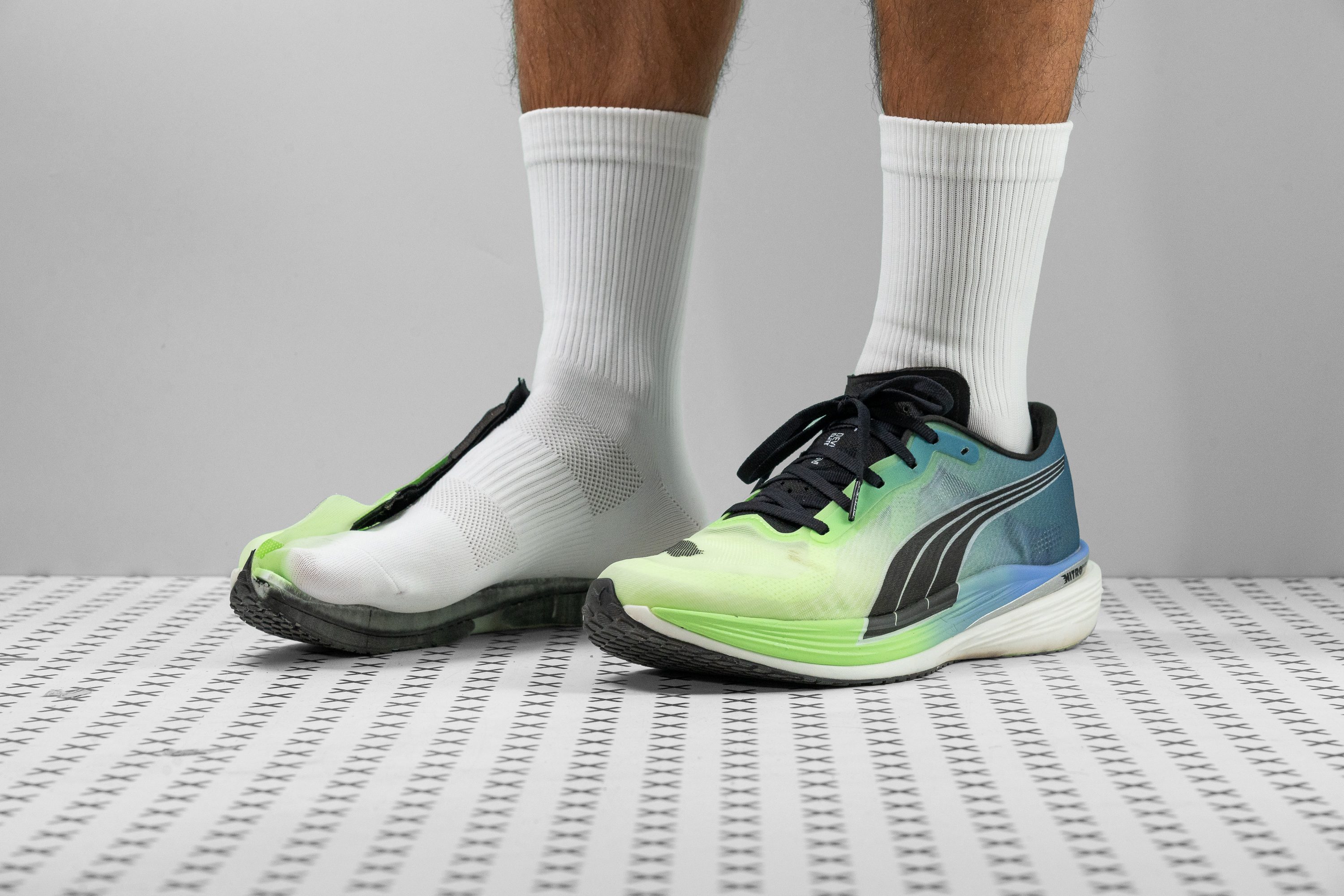Our verdict
- Top pick in best marathon running shoes (2024)
- Top pick in best Running shoes for 5K and 10K races (2024)
Pros
- Amazing durability
- Plush foam
- Excellent PumaGrip outsole
- Better for heel strikers
- Responsive PWRPLATE carbon plate
- Accommodates medium-to-wide feet
- Perfect for tempo runs
Cons
- Heavier than v1
- Still lacks race-day vibe
Audience verdict
Comparison
The most similar running shoes compared
+ + Add a shoe | |||||
|---|---|---|---|---|---|
| Audience score | 85 Good! | 88 Great! | 90 Superb! | 92 Superb! | |
| Price | £200 | £285 | £195 | £160 | |
| Pace | Competition | Competition | CompetitionTempo | CompetitionTempo | |
| Shock absorption | - | High | High | High | |
| Energy return | - | High | High | Moderate | |
| Traction | - | Moderate | High | High | |
| Arch support | Neutral | Neutral | Neutral | Neutral | |
| Weight lab Weight brand | 7.5 oz / 214g 7.4 oz / 210g | 7.1 oz / 201g 7 oz / 198g | 7.2 oz / 204g 7.4 oz / 209g | 8.4 oz / 237g 8.5 oz / 242g | |
| Lightweight | ✓ | ✓ | ✓ | ✓ | |
| Drop lab Drop brand | 9.1 mm 6.0 mm | 8.5 mm 8.0 mm | 10.6 mm 8.0 mm | 9.6 mm 8.0 mm | |
| Strike pattern | HeelMid/forefoot | HeelMid/forefoot | Heel | HeelMid/forefoot | |
| Size | True to size | Slightly small | True to size | True to size | |
| Midsole softness | Soft | Soft | Soft | Soft | |
| Difference in midsole softness in cold | Big | Small | Normal | Small | |
| Toebox durability | Decent | Bad | Bad | Good | |
| Heel padding durability | Good | Good | Good | Good | |
| Outsole durability | - | Bad | Decent | Good | |
| Breathability | Breathable | Breathable | Moderate | Breathable | |
| Width / fit | Narrow | Medium | Medium | Medium | |
| Toebox width | Medium | Medium | Narrow | Medium | |
| Stiffness | Stiff | Stiff | Stiff | Stiff | |
| Torsional rigidity | Stiff | Stiff | Stiff | Stiff | |
| Heel counter stiffness | Flexible | Flexible | Flexible | Flexible | |
| Plate | Carbon plate | Carbon plate | Carbon plate | Carbon plate | |
| Rocker | ✓ | ✓ | ✓ | ✓ | |
| Heel lab Heel brand | 35.0 mm 36.0 mm | 38.1 mm 40.0 mm | 39.2 mm 40.0 mm | 42.5 mm 43.5 mm | |
| Forefoot lab Forefoot brand | 25.9 mm 30.0 mm | 29.6 mm 32.0 mm | 28.6 mm 32.0 mm | 32.9 mm 35.5 mm | |
| Widths available | Normal | Normal | Normal | NormalWide | |
| Orthotic friendly | ✓ | ✗ | ✓ | ✓ | |
| Season | SummerAll seasons | SummerAll seasons | All seasons | SummerAll seasons | |
| Removable insole | ✓ | ✗ | ✓ | ✓ | |
| Ranking | #421 Bottom 36% | #137 Top 37% | #38 Top 11% | #16 Top 5% | |
| Popularity | #439 Bottom 33% | #23 Top 7% | #49 Top 14% | #61 Top 17% |
Who should buy
For those in search of a durable racer with unparalleled grip, we think that the Deviate Nitro Elite 2 steps up as a fantastic pick. We loved it's roomy—for being a speedster—toebox and plush midsole. And it worked wonders on our fast paced efforts, from brief to prolonged intervals, races and even our longest runs!

Who should NOT buy
Let's be clear, the PUMA Deviate Nitro Elite 2 is a jaw-dropping shoe, but it may not be the perfect fit for everyone.
- For runners with narrow feet or high arches, the Nike Vaporfly Next% 2 is the perfect match.
- If you're searching for top-of-the-line foam, the ASICS Metaspeed Sky+ is worth considering with its world-class PEBA midsole.
- Heel strikers might find a higher-drop shoe like the Adidas Adizero Adios Pro 2.0 more appealing.
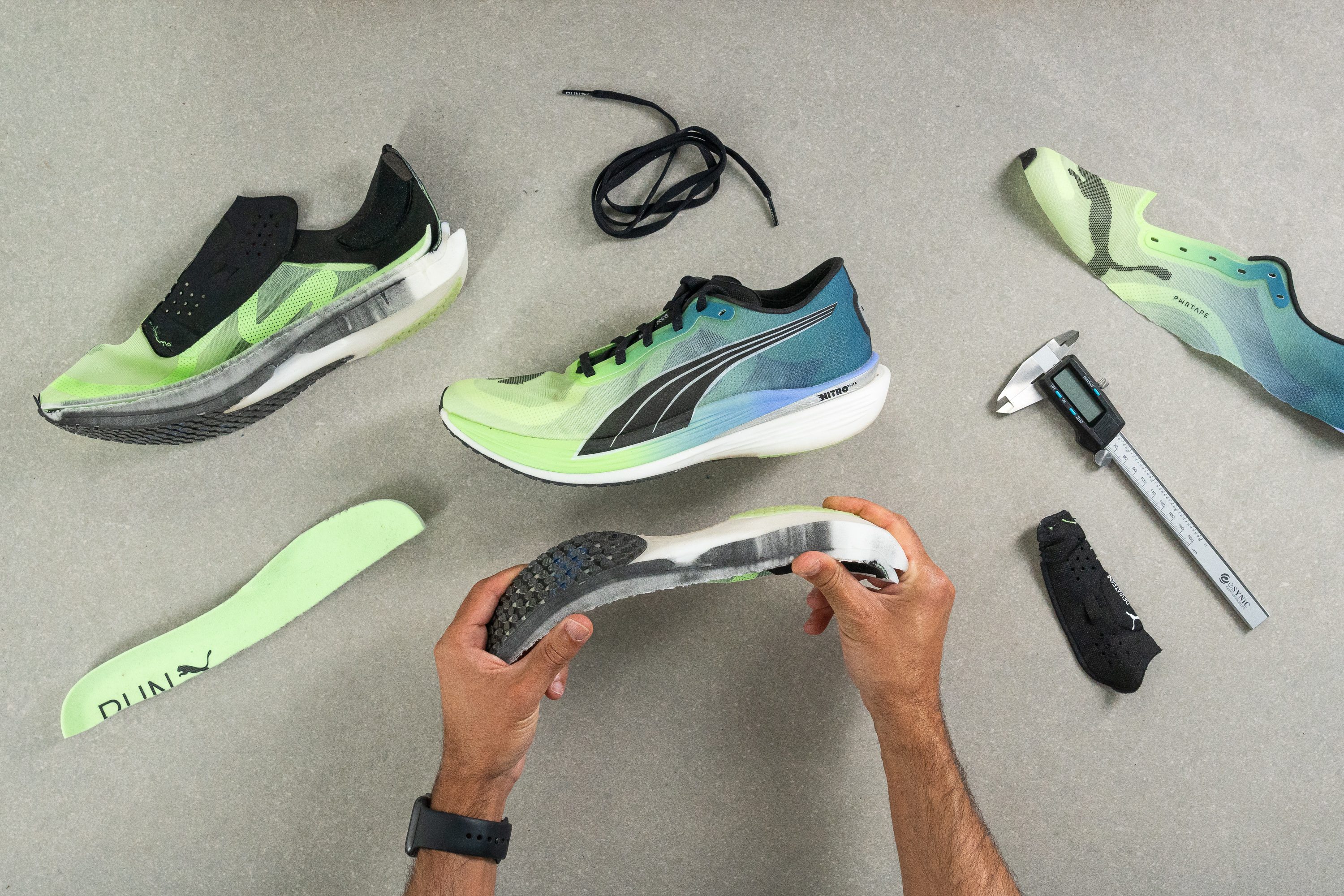
And if you're in search of a solid tempo shoe, the Endorphin Speed 3 performs at least at the same level and it's £30 cheaper.
Cushioning
Heel stack
We weren't very happy with the 1st-gen Deviate Nitro Elite for its 31.1 mm cushioning, clearly inadequate for today's standards on marathon racing.
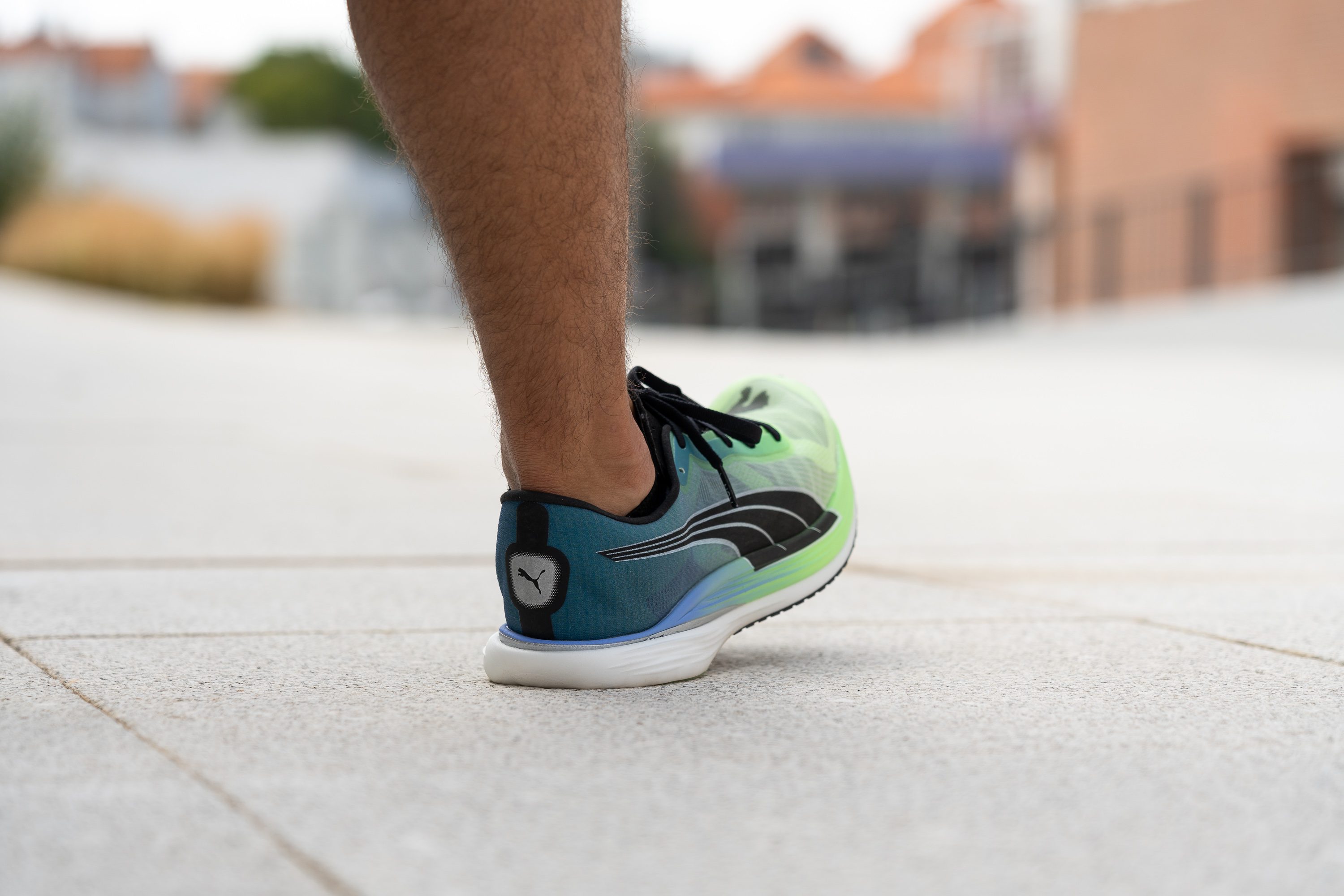
Heeding this feedback, PUMA upped the ante with a heel stack height of 35 mm in v2—nearly 4 mm more than its predecessor and just a millimetre short of the brand's official 36 mm figure. That's nice!

| Deviate Nitro Elite 2 | 35.0 mm |
| Average | 34.8 mm |
Forefoot stack
On the other hand, the forefoot's measurement remains nearly unchanged at 25.9 mm, which is surprising given the fact that PUMA says it should be 30 mm.
Considering the Nitro Elite cloud-like softness, we think that the shoe may not offer enough cushioning for heavy runners that strike the ground with the forefoot.
Indeed, it's higher than the average shoe, but remember, this isn't designed as a daily trainer where an abundance of cushion isn't necessary. It's supposed to be a long-distance racer.
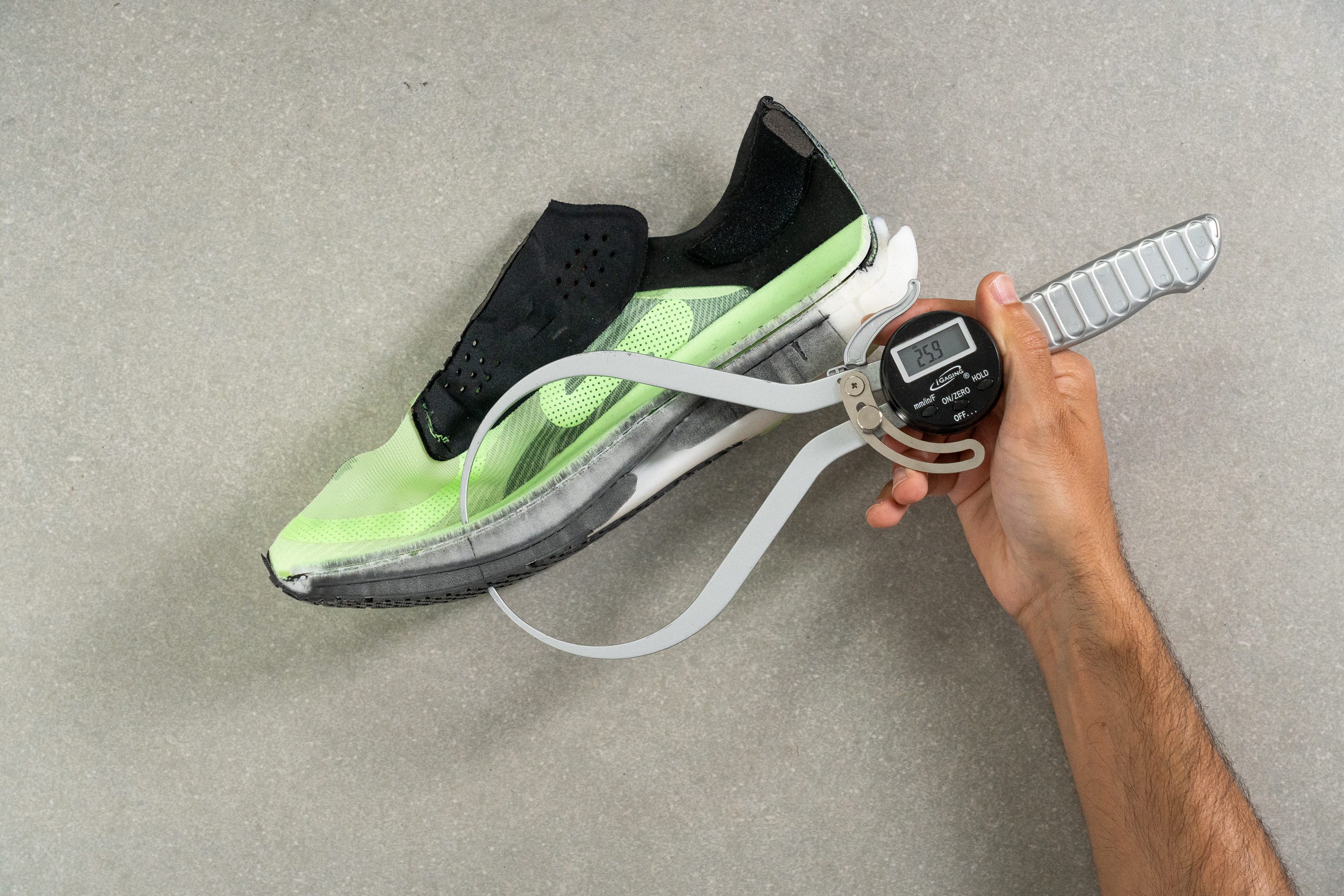
| Deviate Nitro Elite 2 | 25.9 mm |
| Average | 26.2 mm |
Drop
We noticed that while the heel measurement increased, the forefoot remained nearly the same as before. This simple equation yields a clear result: a higher drop of 9.1 mm.
This measurement is far from the brand's claimed 6-mm heel-to-toe drop and brings a few consequences with it. The most evident of these is that, with more Nitro Elite foam in the heel and a greater drop, the DNE2 is better suited for heel strikers.
For this reason, PUMA also incorporated a rockered shape into this model. It promotes a smoother transition from heel to toe.
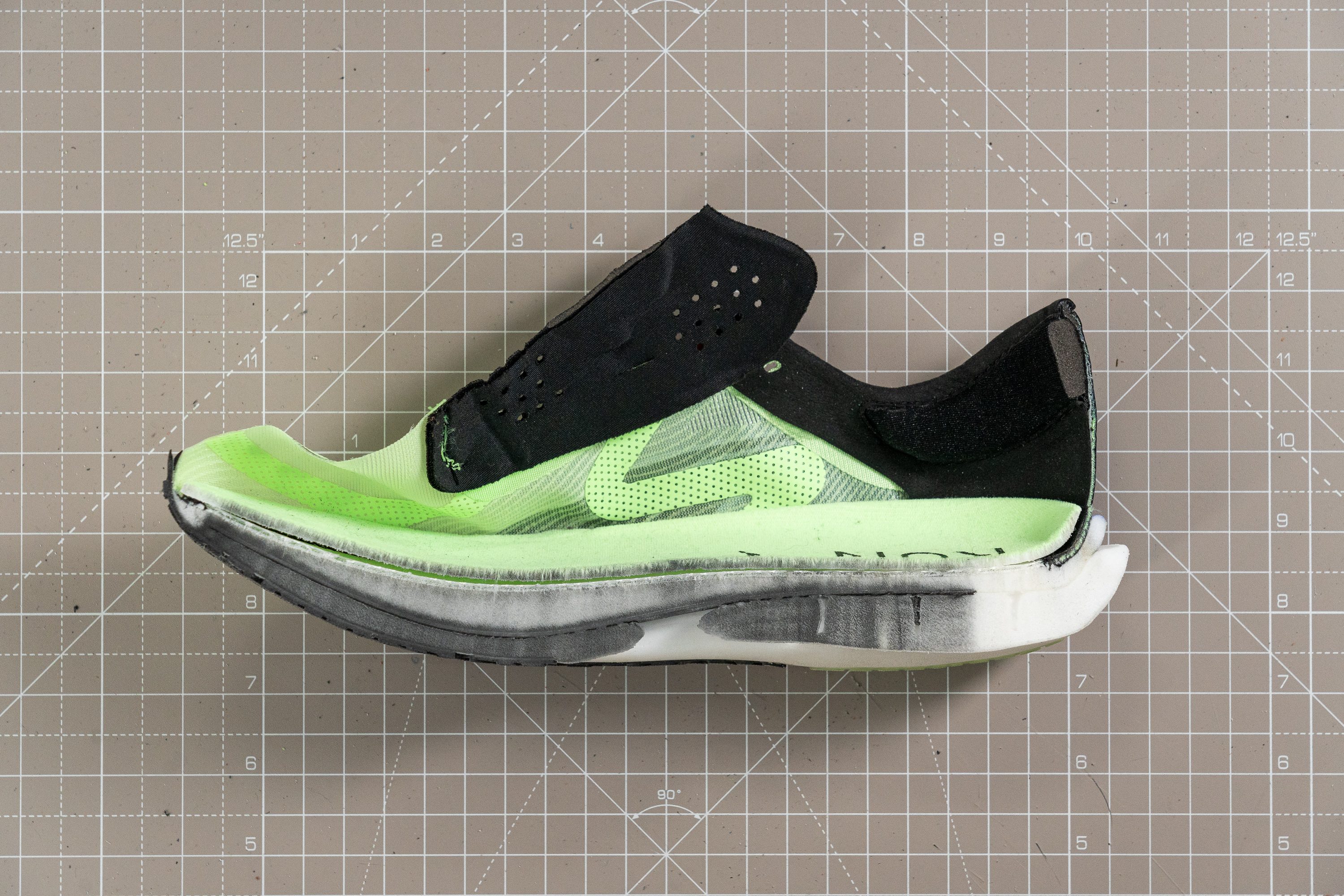
| Deviate Nitro Elite 2 | 9.1 mm |
| Average | 8.6 mm |
Midsole softness
One of the things we LOVE at RunRepeat about lab-testing shoes is the objective truth we uncover. The numbers tell the story themselves. That's exactly what unfolded when we measured the midsole softness in the Deviate Nitro Elite 2.
Contrary to many people's belief that the new iteration was firmer than its predecessor, our testing revealed the opposite—this Nitro Elite foam (PEBA+EVA) it's softer!
We measured it at 13.9 HA, so it's among the softest foams we've ever seen, proving to be 6% plushier than the first version.
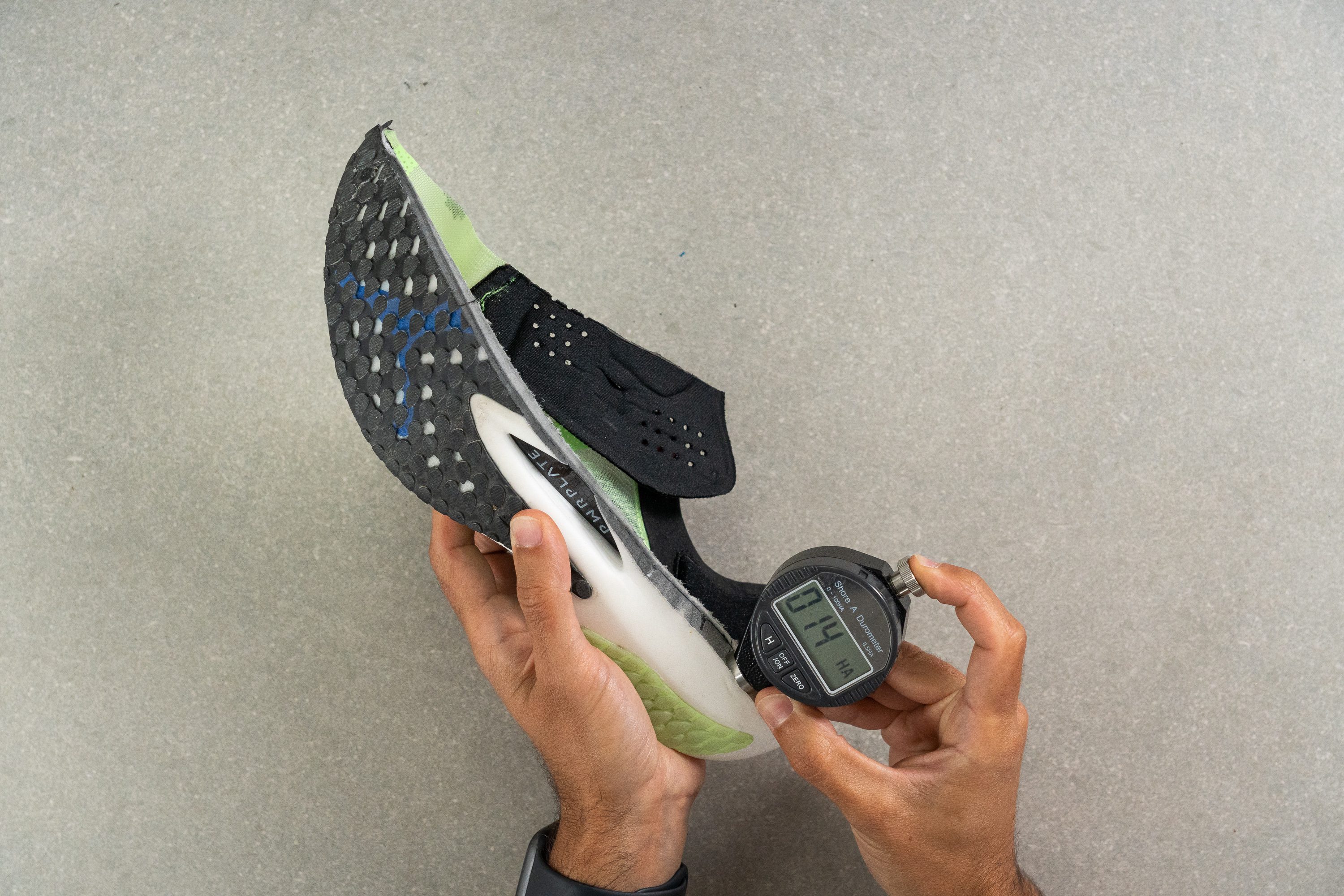
| Deviate Nitro Elite 2 | 13.9 HA |
| Average | 20.4 HA |
Size and fit
Size
PUMA Deviate Nitro Elite 2 fits true to size (23 votes).
Width / Fit
It's interesting to note that we put the Deviate Nitro Elite 2 to the test in our lab just after trying out the Elite 1, and we found that our feet had more room than before.
That's why whe think that the first version is a great fit for those with narrow feet, while this v2 is a better match for runners with medium or even wide feet.
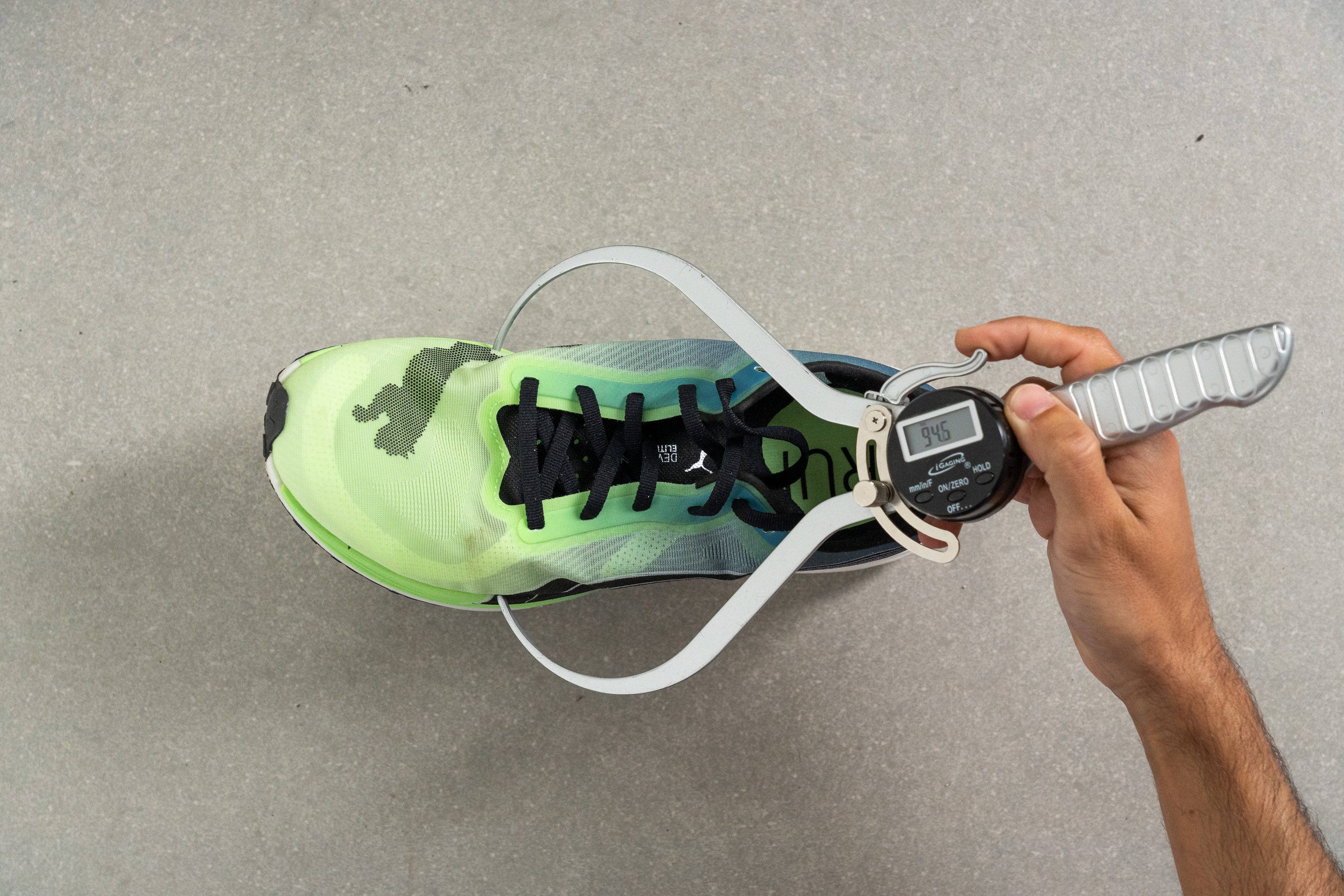
This test follows an older methodology, which is why you don't see recently tested shoes in the chart. Results from different methodologies can not be compared.
| Deviate Nitro Elite 2 | 94.6 mm |
| Average | 98.5 mm |
Toebox width
PUMA added again a little extra room in the toe area to make more runners happy. They made the space around the big toe similar to what you find in daily training shoes—in fact, at 72.8 mm, it's wider than the average shoe.

This test follows an older methodology, which is why you don't see recently tested shoes in the chart. Results from different methodologies can not be compared.
| Deviate Nitro Elite 2 | 75.4 mm |
| Average | 78.4 mm |
Flexibility / Stiffness
The Elite 2's performance in this test was just the one we expected.
Given that it's a racing shoe, we anticipated a low measurement but also a higher-than-average number when compared to the average shoe—same as with torsional rigidity.
And that's exactly what we found. It took us 37.6N of force to bend the shoe up to a 90-degree angle.
This test follows an older methodology, which is why you don't see recently tested shoes in the chart. Results from different methodologies can not be compared.
| Deviate Nitro Elite 2 | 37.6N |
| Average | 28.1N |
Stiffness in cold (%)
The shoe's performance following its 20-minute nap in the freezer is, once again, disappointing. It felt very stiff to us, and our testing confirmed this with a readout of 53.7N.
This represents a 42.7% increase from our room-temperature measurement. Although this is slightly better than the average performance, it falls disappointingly short for a £200 shoe. But it's the price to pay for using a mix of PEBA and EVA in the midsole—more about this in our advanced guide.
We're holding out hope that PUMA, in future models, will level up to the offerings of ASICS (FF Turbo) or Nike (ZoomX) by incorporating a full-PEBA midsole compound.
| Deviate Nitro Elite 2 | 43% |
| Average | 33% |
Weight
Upon taking the shoe into the lab, we could instantly tell it wasn't the lightest racing shoe—not surprising given its 32% rubber increase, extra foam, and wider build than its predecessor.
Given these enhancements, a 0.4 oz (14g) uptick in weight from v1 might seem justifiable, yet it may detract us from picking the Elite 2 for a very important race.
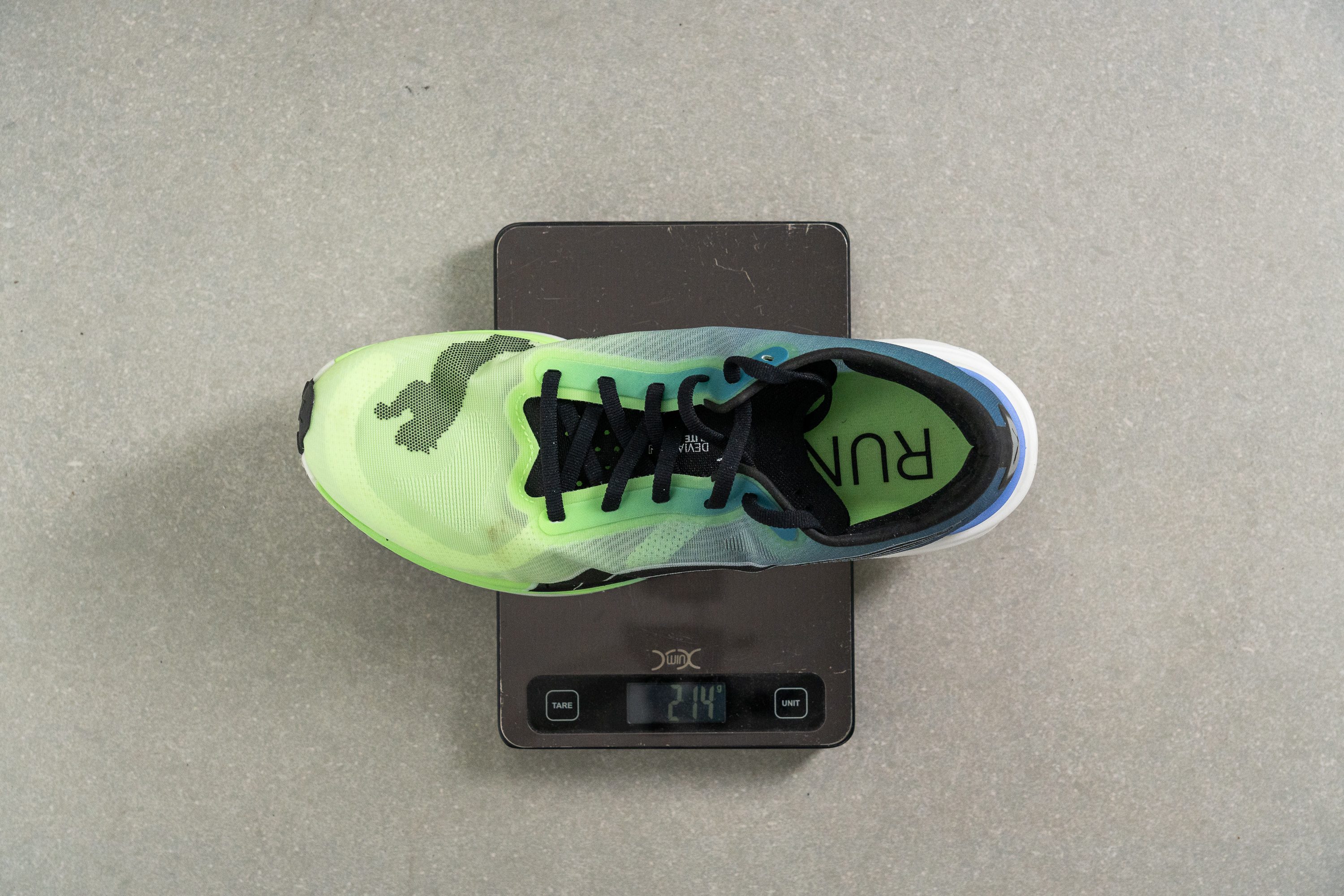
| Deviate Nitro Elite 2 | 7.5 oz (214g) |
| Average | 9.3 oz (264g) |
Breathability
One of the things we LOVE at RunRepeat about lab-testing shoes is the objective truth we uncover. The numbers tell the story themselves. That's exactly what unfolded when we measured the midsole softness in the Deviate Nitro Elite 2.
Contrary to many people's belief that the new iteration was firmer than its predecessor, our testing revealed the opposite—this Nitro Elite foam (PEBA+EVA) it's softer!
[section_break]We measured it at 13.9 HA, so it's among the softest foams we've ever seen, proving to be 6% plushier than the first version.
Breathability
The debut version of the Deviate Nitro Elite was fantastic, boasting exceptional breathability. Naturally, we were in doubt about the revamped upper, wondering if it could match the performance of its predecessor. Yet, the v2 doesn't disappoint and we gave it the same perfect (5/5) score.
Out of the gazillion shoes we've ran this year, only a select few have performed this good under summer's scorching conditions.
Examining the upper in the lab under our microscope really brings to light how this shoe achieves its impressive breathability.

A thin engineered mesh with countless ventilation holes ensures ample airflow for every run, regardless of the heat. Great work PUMA!
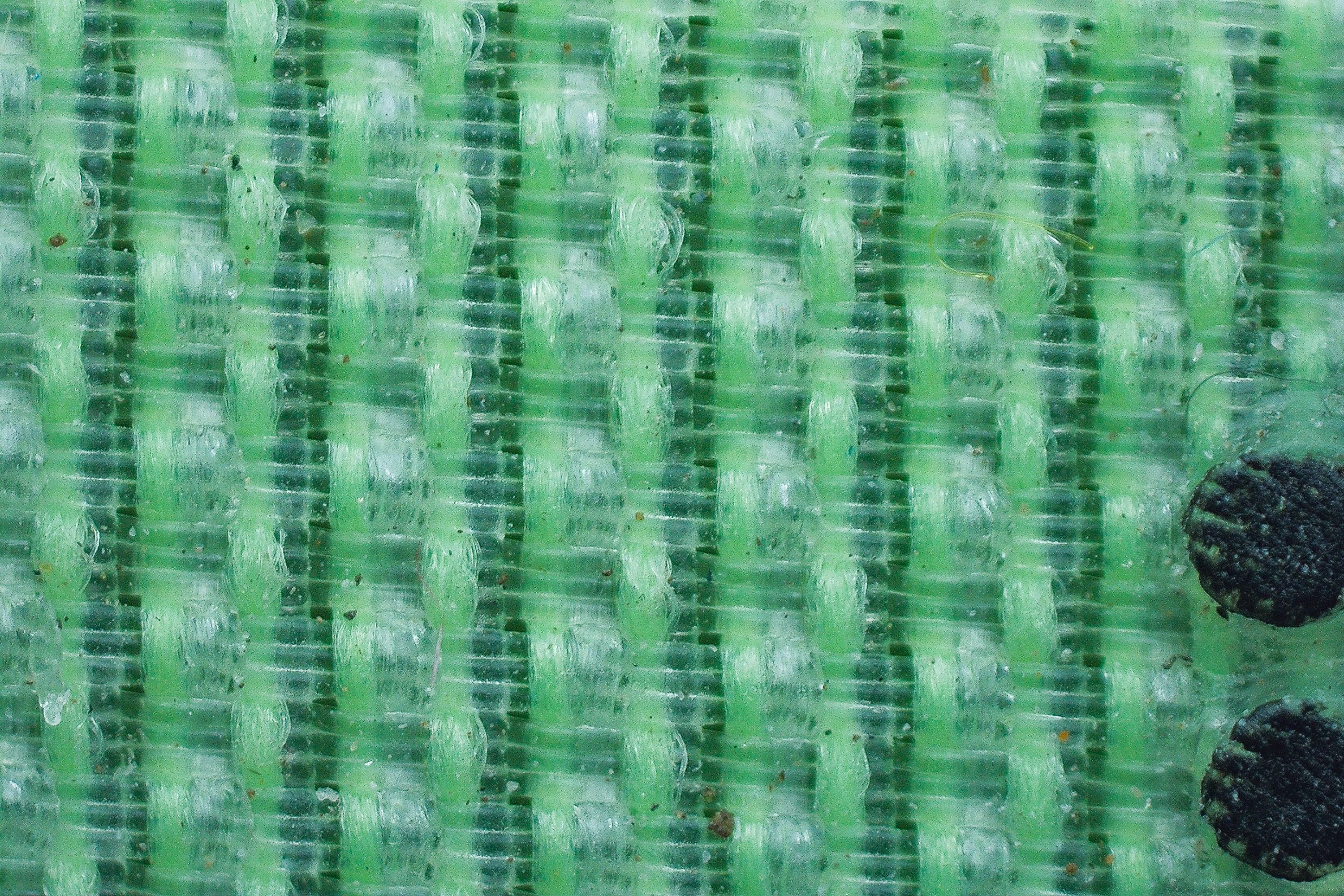
| Deviate Nitro Elite 2 | 5 |
| Average | 3.7 |
Stability
Lateral stability test
Being designed as a neutral racing shoe, this model features midfoot sidewalls for added stability.
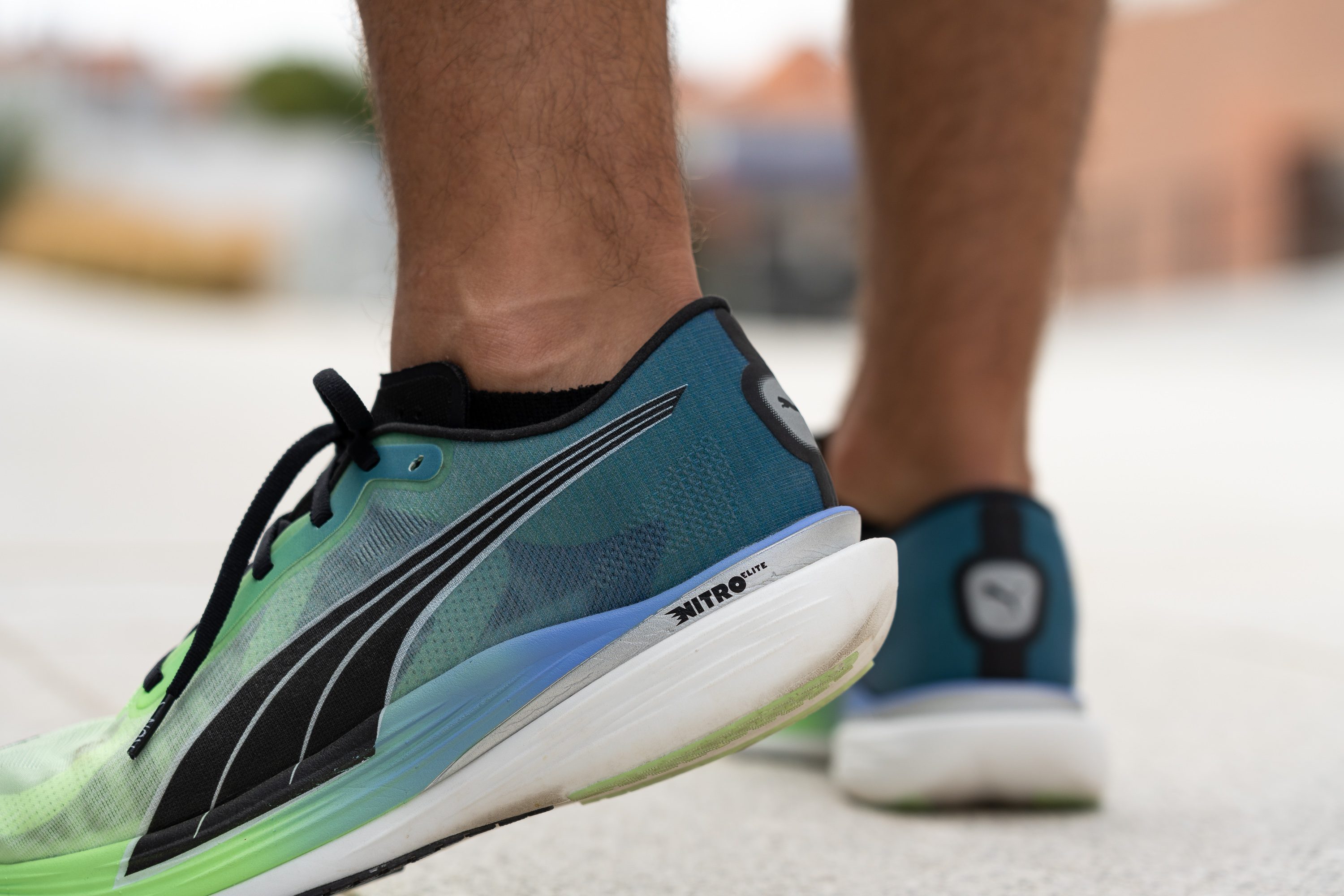
It's significantly more stable than most other racing shoes on the market, but understandably, it doesn't match the stability of a typical daily trainer.
Torsional rigidity
Through our lab evaluation, we credited this shoe with a torsional rigidity score of 4 out of 5. Although it's more flexible than many competitive racing shoes, it boasts superior rigidity compared to the average shoe.
This balance of rigidity and flexibility makes it a nice choice for not only racing but for tempo training and fast-paced long-distance runs. We really enjoyed its versatility.
| Deviate Nitro Elite 2 | 4 |
| Average | 3.5 |
Heel counter stiffness
In contrast to our previous assessment, the heel counter flexibility tells a different story. The Deviate Nitro Elite scored the lowest possible mark of 1 out of 5, which is quite common—and desirable—in this category of shoes.
| Deviate Nitro Elite 2 | 1 |
| Average | 2.9 |
Midsole width - forefoot
We were genuinely surprised by the ample width of the forefoot in the initial Elite version, leading to impressive stability for a race-day shoe.
Adhering to one of the golden rules of running shoe design, PUMA wisely chose not to change a winning feature. They preserved the midsole width almost the same, with our calliper-based measurement clocking it in at 108.1 mm—a mere 1.7 mm less than its predecessor.
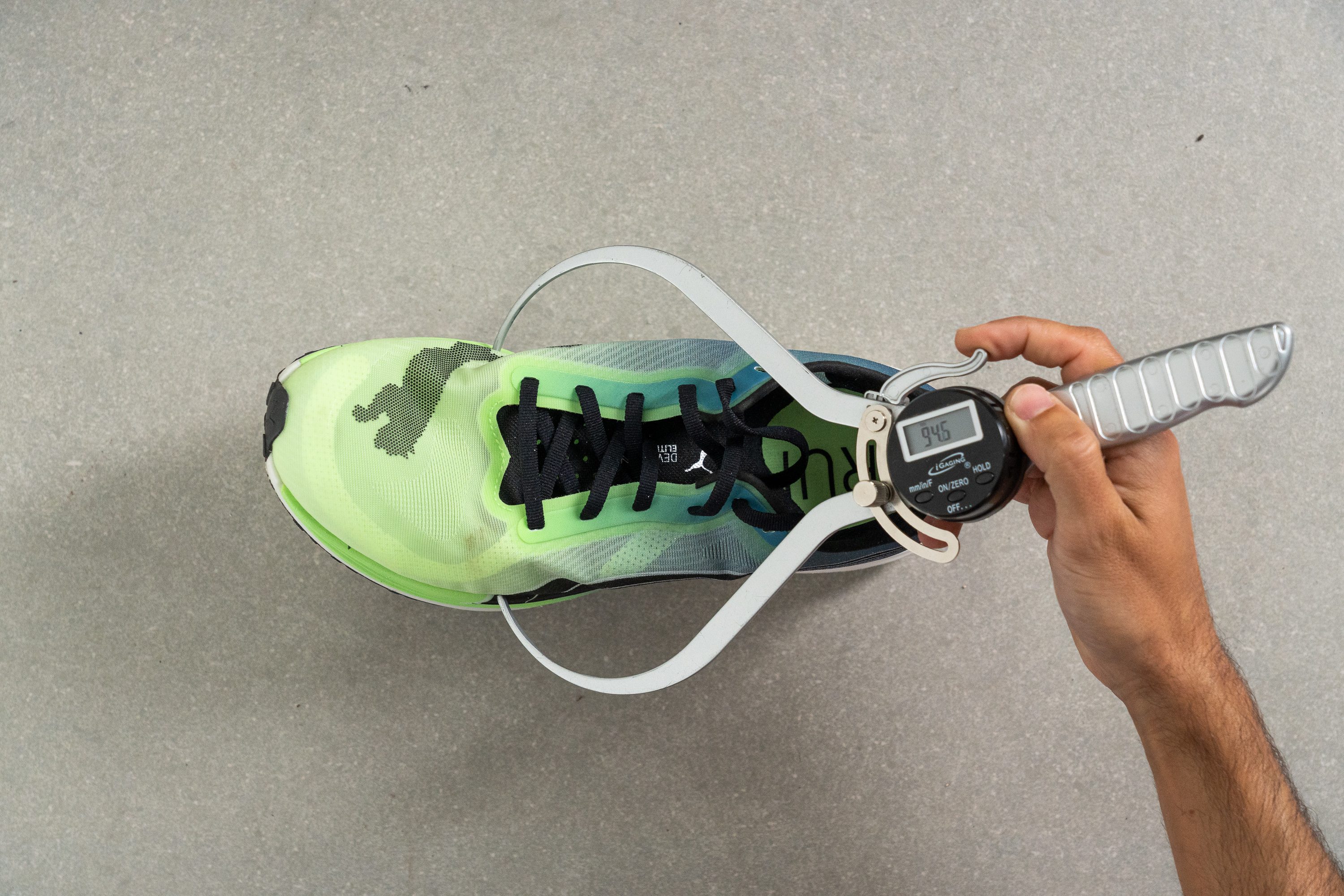
| Deviate Nitro Elite 2 | 108.1 mm |
| Average | 114.4 mm |
Midsole width - heel
We've mentioned before that PUMA aims to please to heel strikers with this second version, and here's another proof: a jaw-dropping wide heel that we measured in the lab at 88.2 mm. For a racing shoe, that's huge.
Consider the previous Elite at 84.7 mm, or even the Nike Vaporfly Next% 2 at 75.0 mm for comparison. PUMA's focus on accommodating heel strikers is clearly evident.
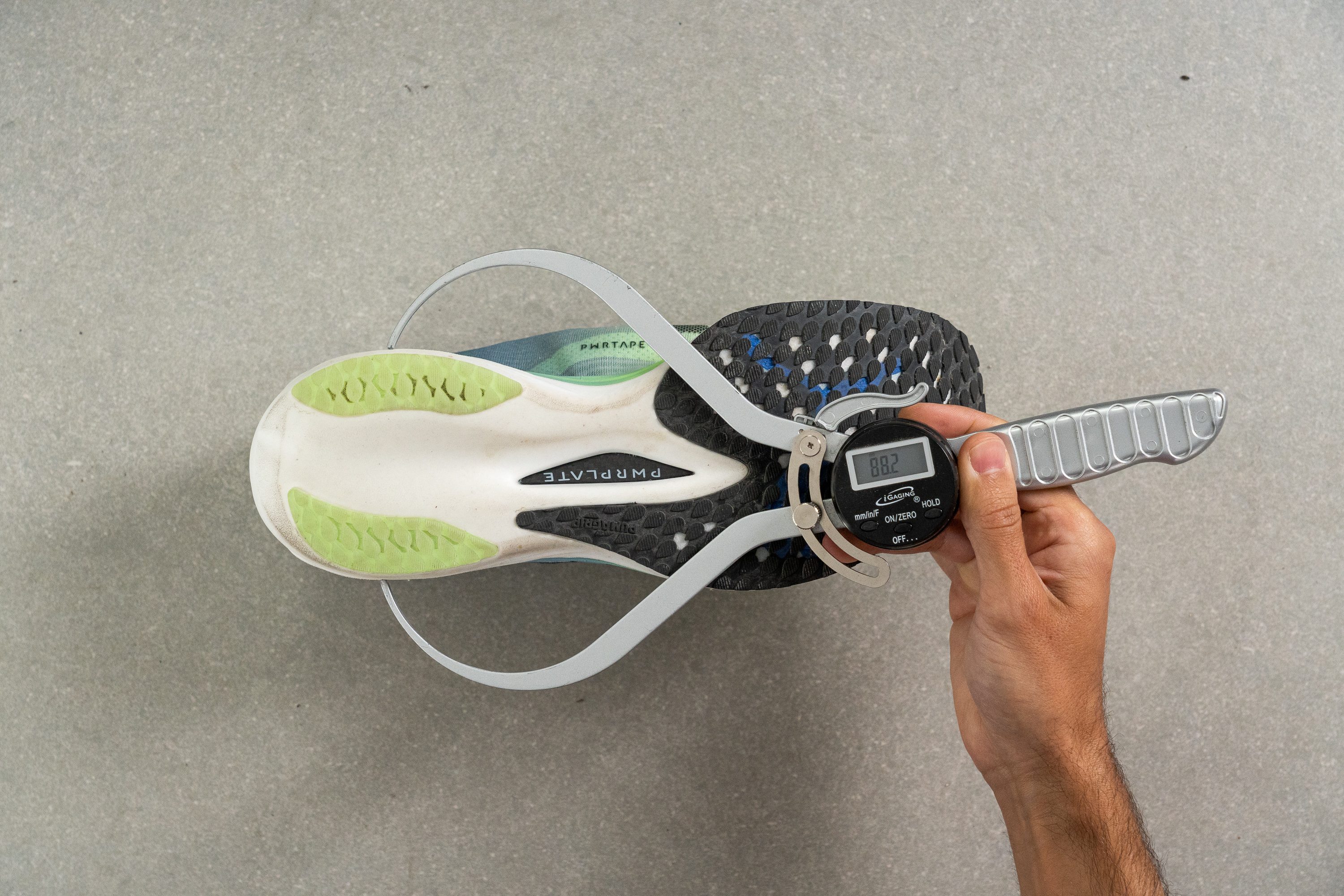
| Deviate Nitro Elite 2 | 88.2 mm |
| Average | 90.7 mm |
Durability
Toebox durability
A major complaint with the OG Deviate Nitro Elite was the upper's susceptibility to tearing. Thus, we really wanted to see this v2 in the lab, subjecting it to our ferocious Dremel test.
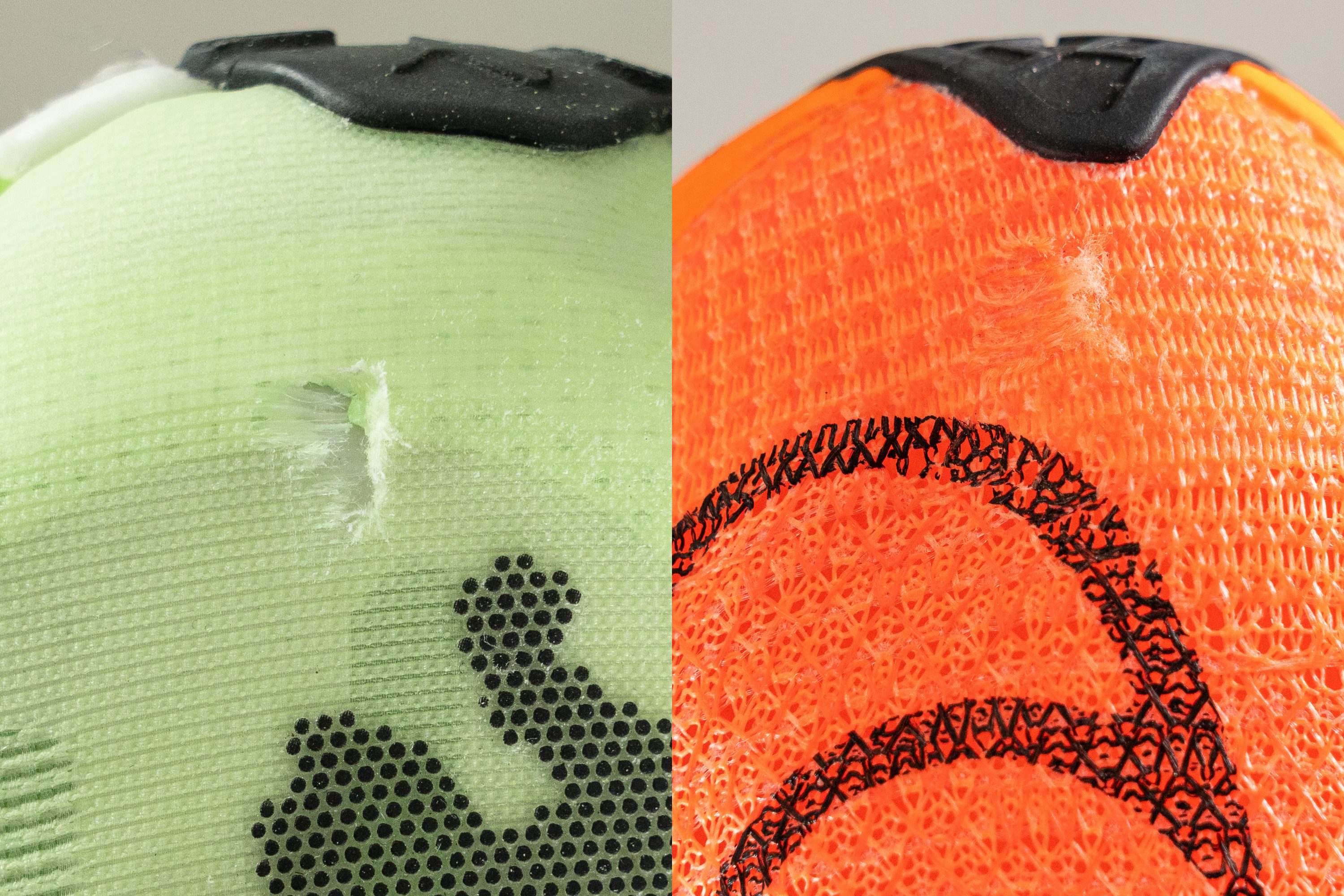
Now, we've got both good and bad news. On a positive note, this shoe significantly improves on its predecessor and we gave it a 2 out of 5. However, there's still room for further improvement as the damage from our test remains quite visible. Unfortunately, the shoe's upper remains somewhat prone to rip and tear.
| Deviate Nitro Elite 2 | 2 |
| Average | 2.6 |
Heel padding durability
This is the DREAM SHOE for those who tend to wear the heel collar. We were astounded in the lab—honestly, we double-checked the Dremel—struggling to believe the minimal damage inflicted on the Deviate Nitro Elite 2.
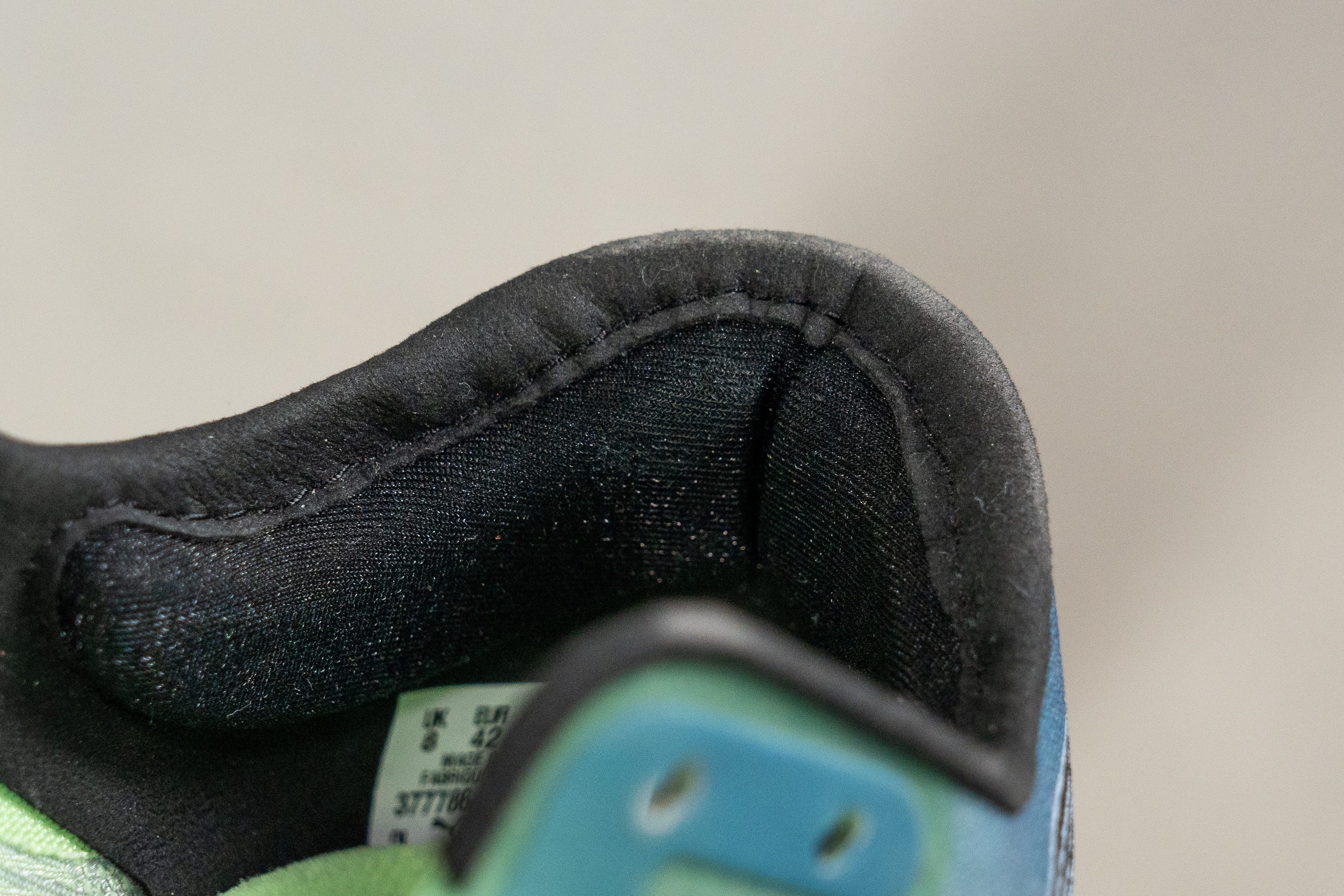
This translates to an outstanding 5/5 score in our test, setting a benchmark that other competition shoes will find near impossible to match.
Along with its impressive durability, the Deviate Nitro Elite features an exceptional amount of padding in the heel area for being a race-day shoe. Great work here, PUMA.
| Deviate Nitro Elite 2 | 5 |
| Average | 3.4 |
Outsole hardness
At 74.8 HC or hardness, PumaGrip strikes an exceptional balance—it's soft enough to ensure superb grip, yet hard enough for noteworthy durability, exceeding most racing shoes.
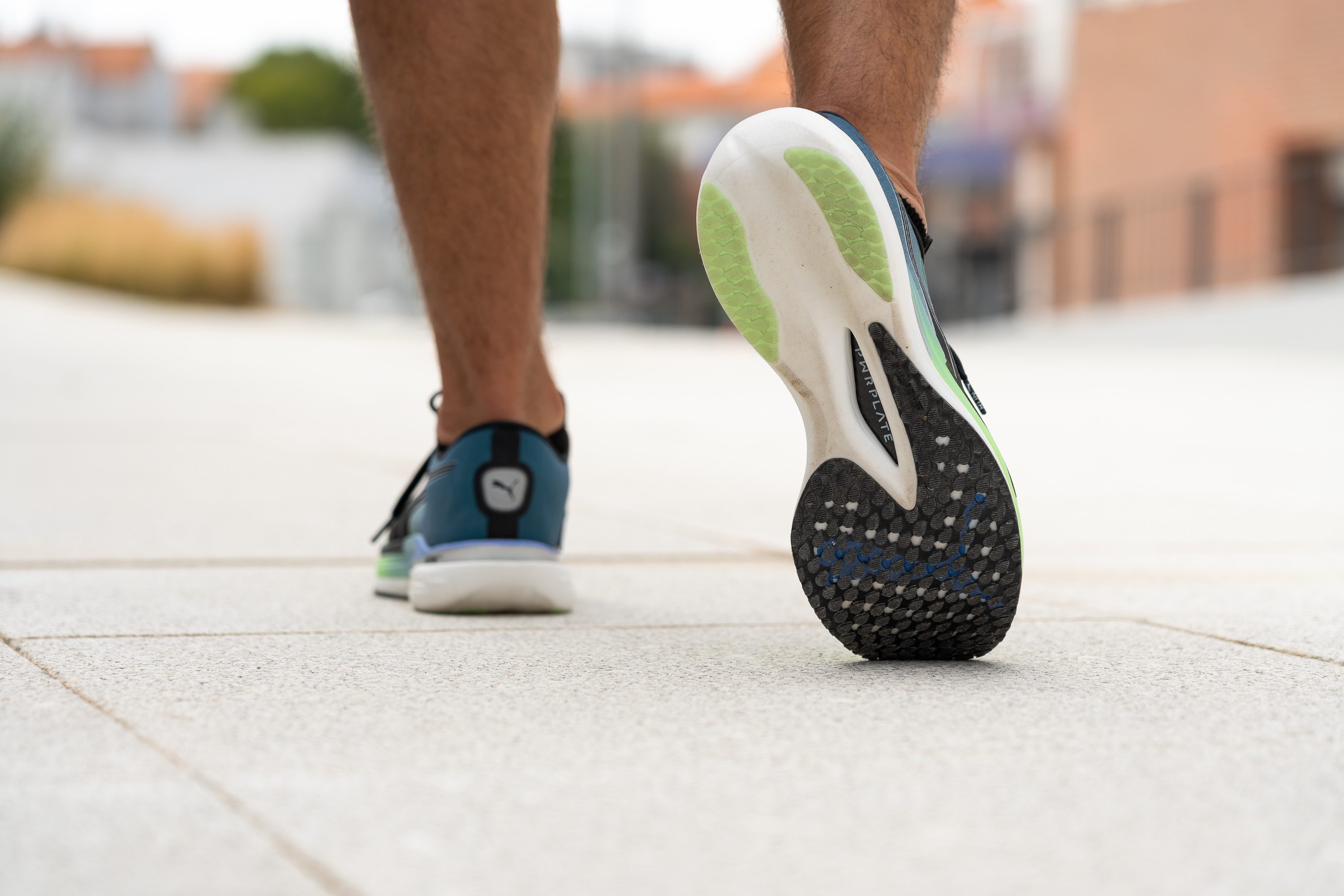
This striking equilibrium, a feature of only certain brands like Adidas (Continental) or PUMA (PumaGrip), is due to their top-tier rubber formulation.
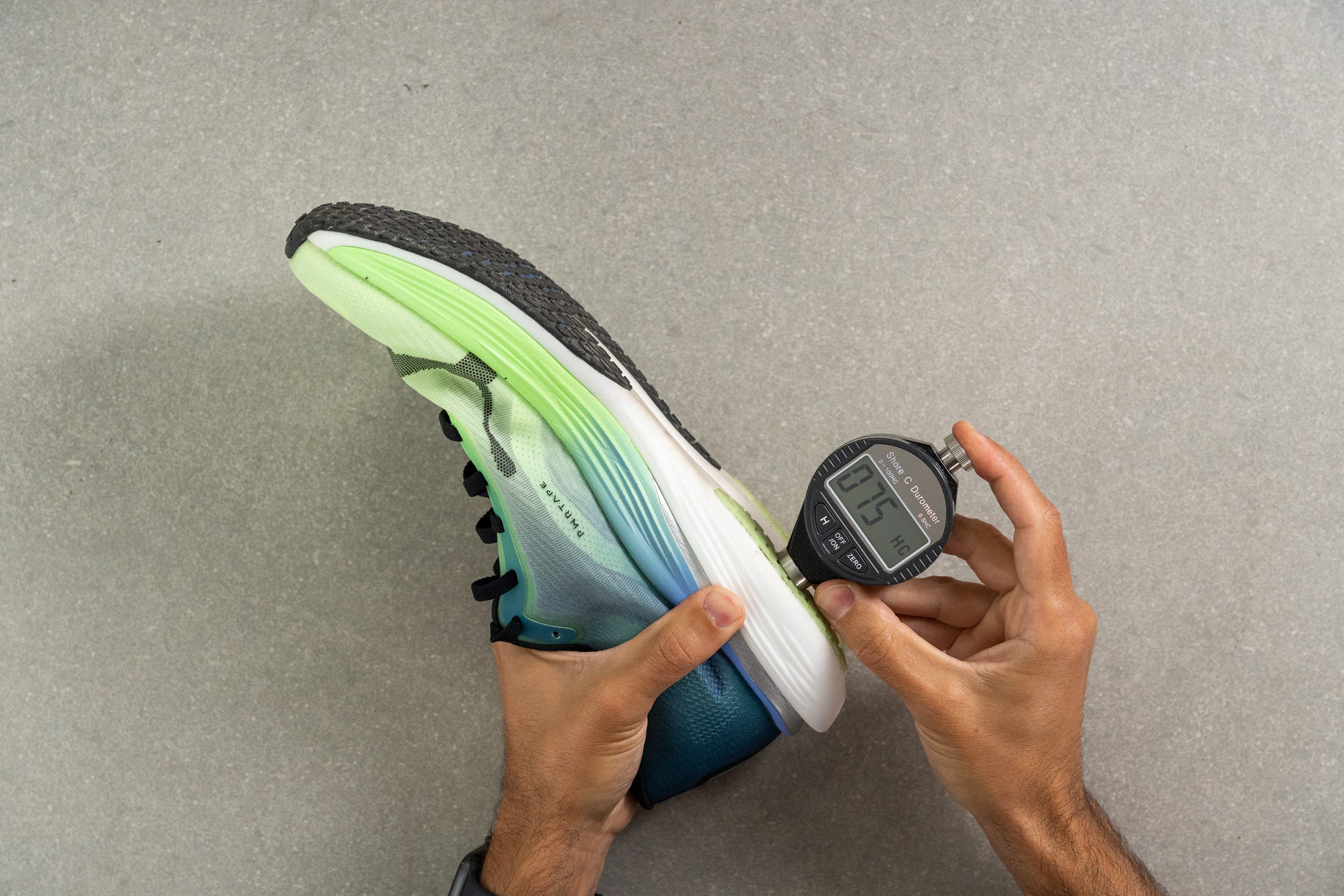
| Deviate Nitro Elite 2 | 74.8 HC |
| Average | 79.2 HC |
Outsole durability
We rated the durability of the outsole at 3/5, falling short of the average shoe.

It's crucial to remember, though, that this model is designed for competition, where durability takes a back seat to reduce weight and improve grip as much as possible.
Outsole thickness
Boasting a generous 2.5 mm rubber layer, this racing shoe truly outshines the competition.
| Shoe | Outsole thickness (mm) | Difference |
| PUMA Deviate Nitro Elite | 1.9 | 32% |
| ASICS Metaspeed Edge+ | 2.1 | 19% |
| Saucony Endorphin Pro 3 | 1.8 | 39% |
| Adidas Adizero Adios Pro 2.0 | 1.0 | 150% |
It's an impressive upgrade that, in our opinion, raises the bar in outsole durability for racing shoes!

| Deviate Nitro Elite 2 | 2.5 mm |
| Average | 3.2 mm |
Misc
Insole thickness
At 3.4 mm, the insole is exactly where it should be—cushioned, yet light.

| Deviate Nitro Elite 2 | 3.4 mm |
| Average | 4.5 mm |
Removable insole
In the Deviate Nitro Elite, the insole isn't glued in place, and we found it really simple to swap it out. The shape of the shoe also welcomes third-party orthotics.
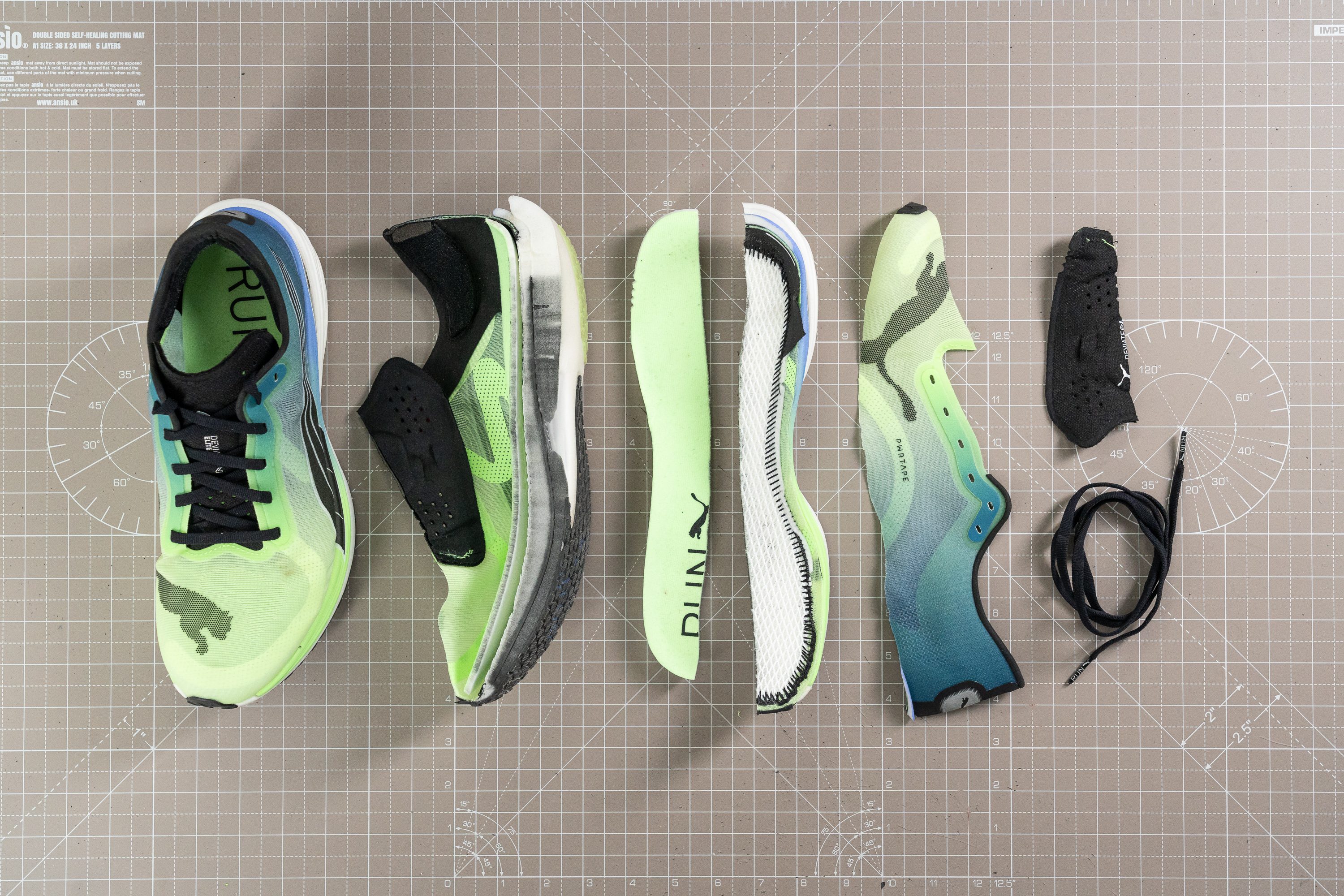
| Deviate Nitro Elite 2 | Yes |
Midsole softness in cold (%)
Why, then, did so many people perceive the v2 as firmer than expected? The answer lies in the timing. This shoe hit the market in February 1st, which is the coldest month in the northern hemisphere.
It seems that early adopters and experts initially tested the Deviate Nitro Elite 2 in cold conditions. Then, we aimed to replicate those conditions by placing the shoe in our freezer for 20 minutes. Upon measurement, we found a hardness of 20.3 HA.
This translates into a 46% increase in firmness after those 20 minutes in the freezer. The disappointing performance for a top-tier shoe is the reason why so many found it unusually firm. Consider this mystery solved!
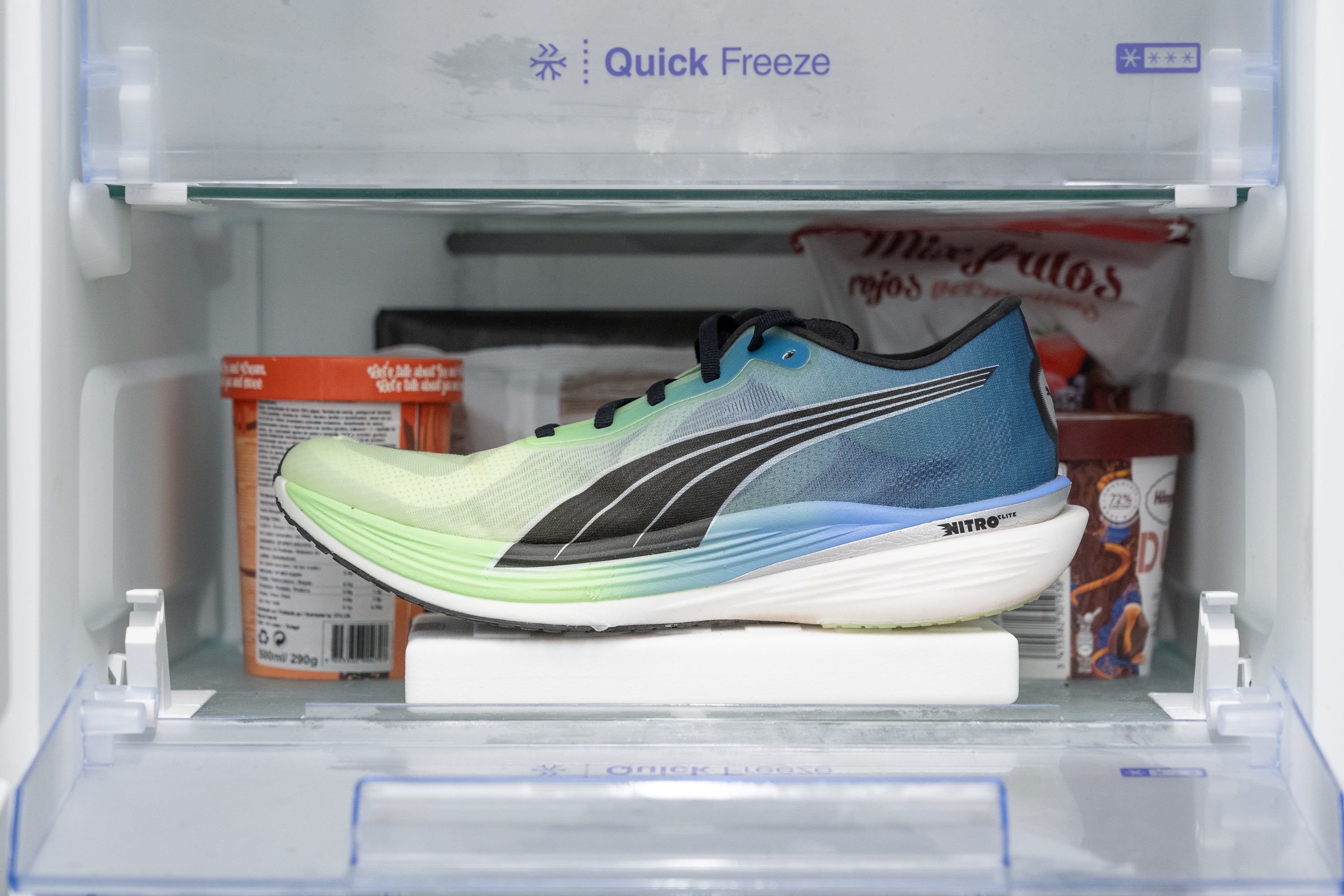
| Deviate Nitro Elite 2 | 46% |
| Average | 24% |
Reflective elements
This shoe really shines in daylight runs, but it's equally excellent for night-time sessions. Thanks to its high-visibility reflective elements in the heel, we felt safer during our afterwork tempo runs.
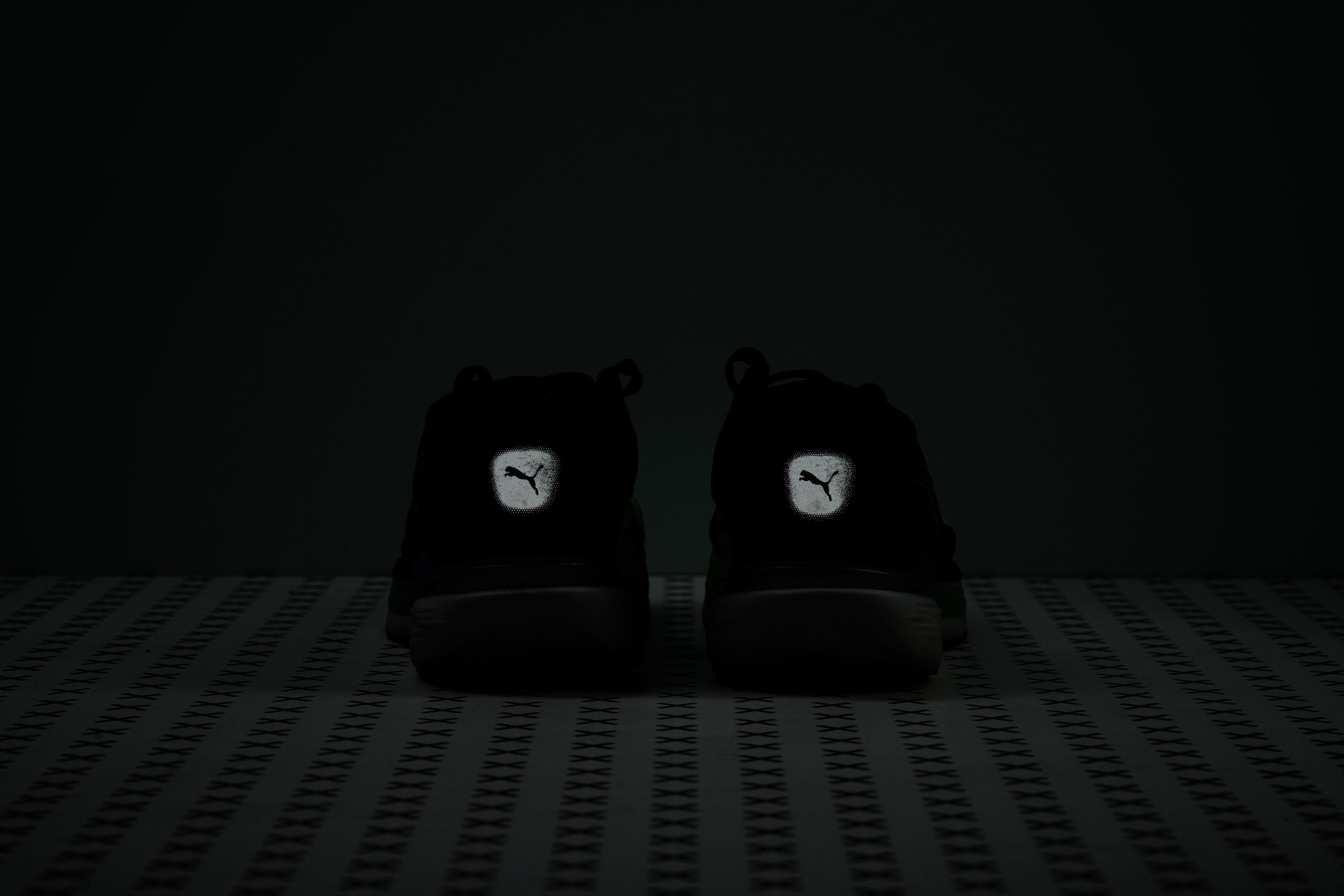
| Deviate Nitro Elite 2 | Yes |
Tongue padding
One common criticism of the world's fastest shoes relates to inadequate tongue padding. This often leads to issues such as lace bite. However, this is not a concern with the Elite 2. We've precisely measured the tongue padding to be 4.9 mm, which is exceptionally thick for a race-day shoe.
Naturally, this is one of the reasons why we feel it might not quite match the market's lightest shoes like the Metaspeed Sky+ or the Vaporfly Next% 2. But at the same time, it offers a level of versatility seldom found in a £200 shoe.
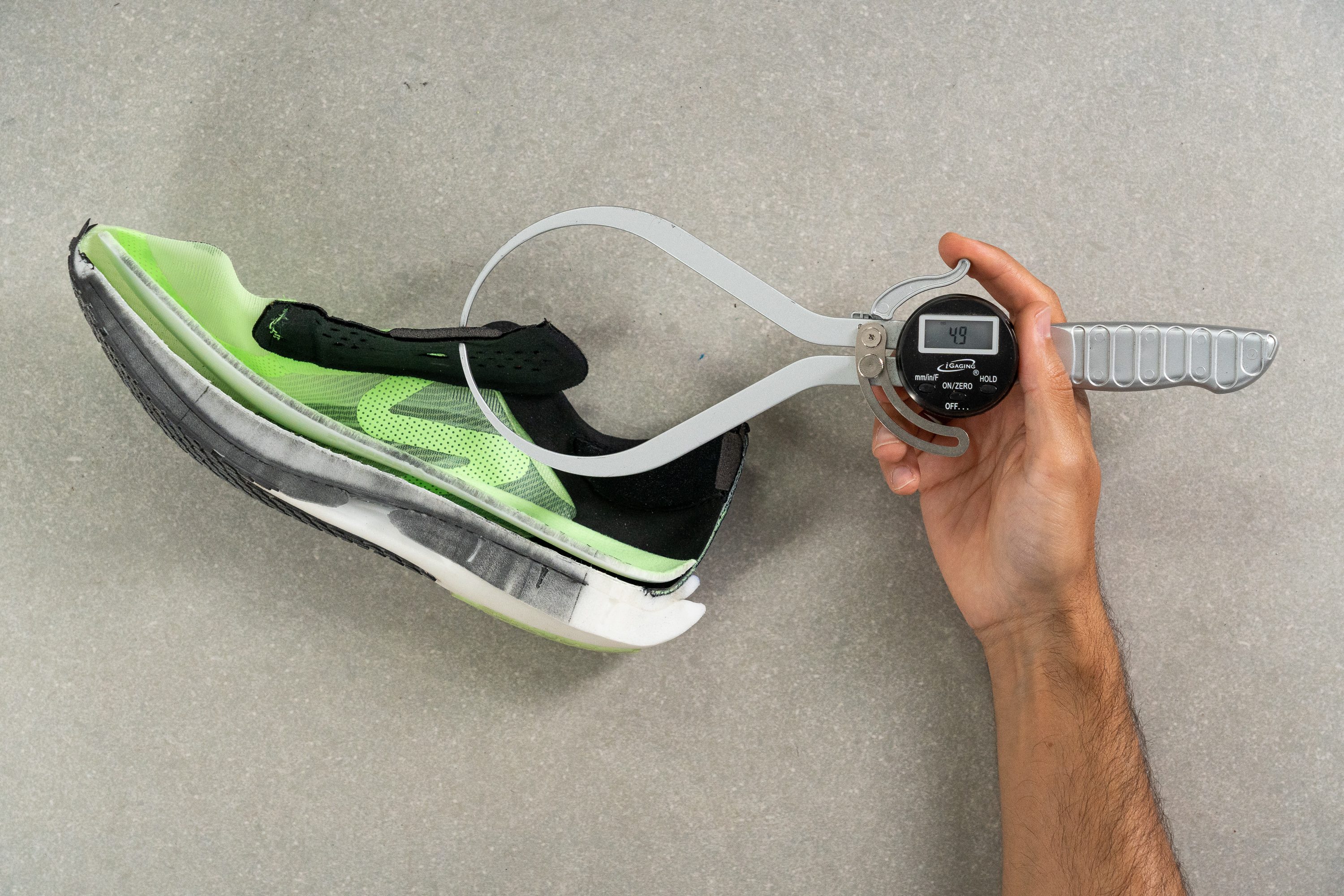
| Deviate Nitro Elite 2 | 4.9 mm |
| Average | 5.8 mm |
Tongue: gusset type
Shifting away from the bizarre one-sided semi-gusseted tongue found in v1, PUMA has now chosen to cut some weight, providing us with a non-gusseted tongue.
We would have appreciated a semi-gusseted tongue on both sides. Hey, PUMA, could that be a thing for v3?
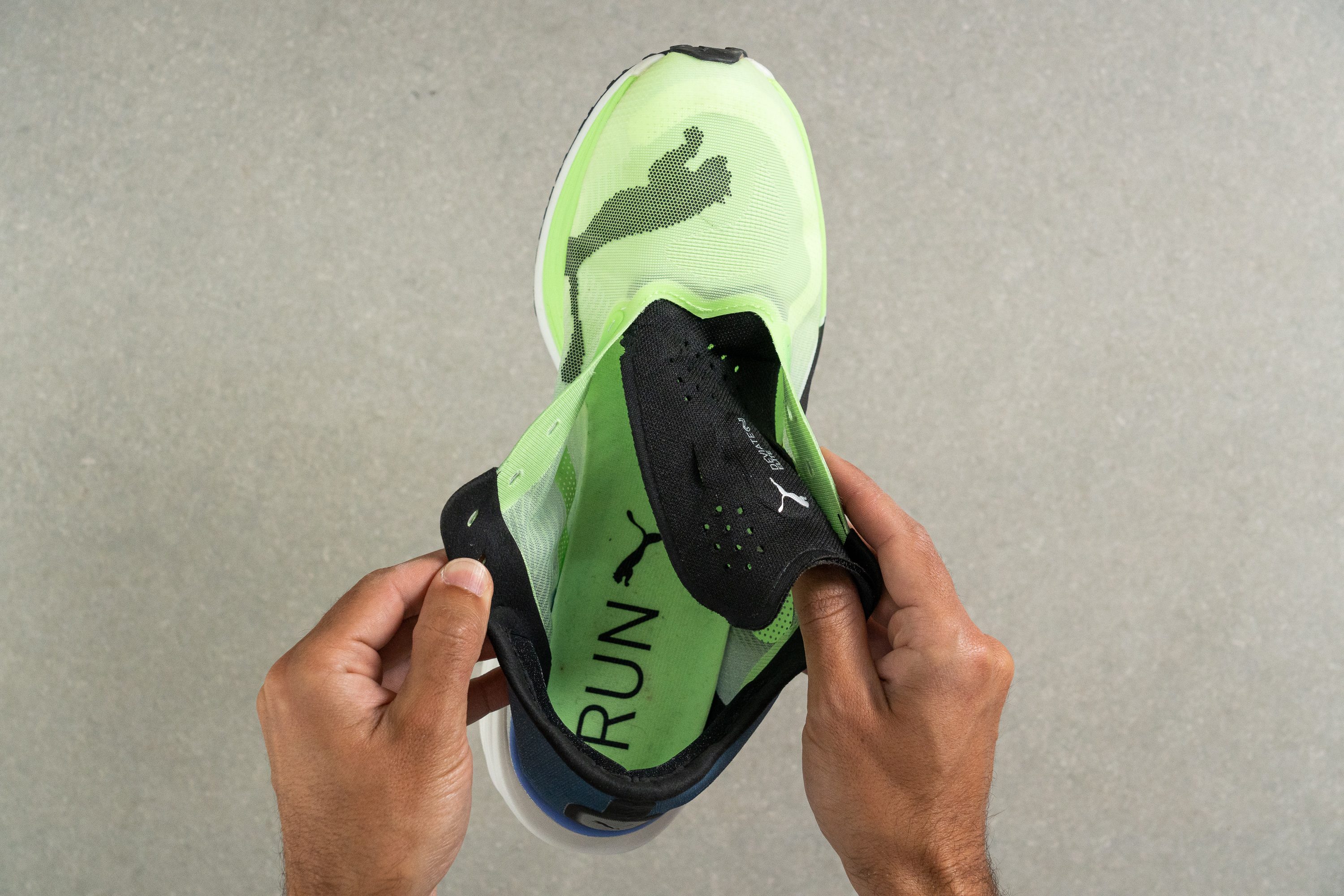
| Deviate Nitro Elite 2 | None |

